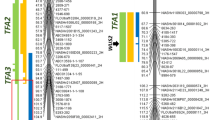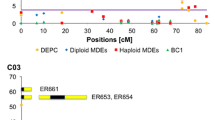Abstract
In the present paper, we report on the selection of two sets of candidate introgression lines (pre-ILs) in spring barley. Two BC2DH populations, S42 and T42, were generated by introgressing an accession of Hordeum vulgare ssp. spontaneum (ISR42-8, from Israel) into two different spring barley cultivars, Scarlett (S) and Thuringia (T). From these BC2DH populations two sets with 49 (S42) and 43 (T42) pre-ILs were selected, and their genomic architecture as revealed by SSR marker analysis was characterised. The selected pre-ILs cover at least 98.1% (S42) and 93.0% (T42) of the exotic genome in overlapping introgressions and contain on average 2 (S42) and 1.5 (T42) additional non-target introgressions. In order to illustrate a potential application and validation of these pre-ILs, the phenotypic effect of the exotic introgression at the locus of the major photoperiod response gene Ppd-H1 was analysed. Pre-ILs carrying the introgression at the Ppd-H1 locus flowered significantly earlier than the elite parents, and the introgression maintained its effect across the two genetic backgrounds and across four tested environments. The selected pre-ILs represent a first promising step towards the assessment and utilization of genetic variation present in exotic barley. They may promote the breeding progress, serve for the verification of QTL effects and provide a valuable resource for the unravelling of gene function, e.g. by expression profiling or map-based cloning.


Similar content being viewed by others
References
Alpert KB, Tanksley SD (1996) High-resolution mapping and isolation of a yeast artificial chromosome contig containing fw2.2: a major fruit weight quantitative trait locus in tomato. Proc Natl Acad Sci USA 93:15503–15507
Becker J, Heun M (1995) Barley microsatellites: allele variation and mapping. Plant Mol Biol 27:835–845
Bernacchi D, Beck-Bunn D, Emmatty D, Eshed T, Inai S, Lopez Y, Petiard V, Sayama H, Uhlig J, Zamir D, Tanksley S (1998) Advanced backcross QTL analysis of tomato. II. Evaluation of near isogenic lines carrying single-donor introgressions for desirable wild QTL-alleles derived from Lycopersicon hirsutum and L. pimpinellifolium. Theor Appl Genet 97:170–180
Brown AHD, Zohary D, Nevo E (1978) Outcrossing rates and heterozygosity in natural populations of Hordeum spontaneum Koch in Israel. Heredity 41:49–62
Chetelat RT, Meglic V (2000) Molecular mapping of chromosome segments introgressed from Solanum lycopersicoides into cultivated tomato (Lycopersicon esculentum). Theor Appl Genet 100:232–241
Costa JM, Corey A, Hayes PM, Jobet C, Kleinhofs A, Kopisch-Obusch A, Kramer SF, Kudrna D, Li M, Riera-Lizarazu O, Sato K, Szucs P, Toojinda T, Vales MJ, Wolfe RI (2001) Molecular mapping of the Oregon Wolfe Barleys: a phenotypically polymorphic doubled-haploid population. Theor Appl Genet 103:415–424
Cox TS (1984) Expectations of means and genetic variances in backcross populations. Theor Appl Genet 68:35–41
Dorweiler J, Stec A, Kermicle J, Doebley J (1993) Teosinte-glume-architecture-1-a genetic-locus controlling a key step in maize evolution. Science 262(5131):233–235
Dunnett CW (1955) A multiple comparisons procedure for comparing several treatments with a control. J Am Stat Assoc 50:1096–1121
Eshed Y, Zamir D (1994) A genomic library of Lycopersicon pennellii in Lycopersicon esculentum—a tool for fine mapping of genes. Euphytica 79(3):175–179
Eshed Y, Zamir D (1995) An introgression line population of Lycopersicon pennellii in the cultivated tomato enables the identification and fine mapping of yield-associated QTL. Genetics 141: 1147–1162
Eshed Y, Abu-Abied M, Saranga Y, Zamir D (1992) Lycopersicon esculentum lines containing small overlapping introgressions from L. pennellii. Theor Appl Genet 83:1027–1034
Frary A, Doganlar S, Frampton A, Fulton T, Uhlig J, Yates H, Tanksley S (2000) Fine mapping of quantitative trait loci for improved fruit characteristics from Lycopersicon chmielewskii chromosome 1. Genome 46(2):235–243
Fulton TM, Beck-Bunn T, Emmatty D, Eshed Y, Lopez J, Petiard V, Uhlig J, Zamir D, Tanksley SD (1997) QTL analysis of an advanced backcross of Lycopersicon peruvianum to the cultivated tomato and comparisons with QTLs found in other wild species. Theor Appl Genet 95:881–894
Hayes PM, Liu BH, Knapp SJ, Chen F, Jones B, Blake T, Franckowiak J, Rasmusson D, Sorrells M, Ullrich SE, Wesenberg D, Kleinhofs A (1993) Quantitative trait locus effects and environmental interaction in a sample of North American barley germplasm. Theor Appl Genet 87: 392–401
Islam AKMR, Shephard KW, Sparrow DHB (1981) Isolation and characterization of euplasmic wheat–barley chromosome addition lines. Heredity 46:161–174
Jeuken MJW, Lindhout P (2004) The development of lettuce backcross inbred lines (BILs) for exploitation of the Lactuca saligna (wild lettuce) germplasm. Theor Appl Genet 109:394–401
Kjaer B, Jensen J, Giese H (1995) Quantitative trait loci for heading date and straw characters in barley. Genome 38:1098–1104
Kleinhofs A, Graner A (2001) An integrated map of the barley genome. In: Phillips RL, Vasil IK (eds) DNA-based markers in plants. Kluwer, Dordrecht, pp 187–199
Lander ES, Green P, Abrahamson J, Barlow A, Daly MJ, Lincoln SE, Newburg L (1987) Mapmaker: an interactive computer package for constructing primary genetic linkage maps of experimental and natural populations. Genomics 1:174–181
Laurie DA, Pratchett N, Bezant JH, Snape JW (1994) Genetic analysis of a photoperiod-response gene on the short arm of chromosome 2 (2H) of Hordeum vulgare (barley). Heredity 72:619–627
Lin SY, Sasaki T, Yano M (1998) Mapping quantitative trait loci controlling seed dormancy and heading date in rice, Oryza sativa L., using backcross inbred lines. Theor Appl Genet 96:997–1003
Liu Z-W, Biyashev RM, Saghai Maroof MA (1996) Development of simple sequence repeat DNA markers and their integration into a barley linkage map. Theor Appl Genet 93:869–876
Manly KF, Cudmore RH, Meer JM (2001) Map manager QTX, cross-platform software for genetic mapping. Mamm Genome 12(12):930–932
Matus I, Corey A, Filchkin T, Hayes PM, Vales MI, Kling J, Riera-Lizarazu O, Sato K, Powell W, Waugh R (2003) Development and characterization of recombinant chromosome substitution lines (RCSLs) using Hordeum vulgare subsp. spontaneum as a source of donor alleles in a Hordeum vulgare subsp. vulgare background. Genome 46:1010–1023
Melchinger AE, Utz HF, Schön CC (1998) Quantitative trait locus (QTL) mapping using different testers and independent population samples in maize reveals low power of QTL detection and large bias in estimates of QTL effects. Genetics 149:383–403
Monforte AJ, Tanksley SD (2000) Fine mapping of a quantitative trait locus (QTL) from Lycopersicon hirsutum chromosome 1 affecting fruit characteristics and agronomic traits: breaking linkage among QTLs affecting different traits and dissection of heterosis for yield. Theor Appl Genet 100:471–479
Pan A, Hayes PM, Chen F, Chen THH, Blake T, Wright S, Karsai I, Bedö Z (1994) Genetic analysis of the components of winterhardiness in barley (Hordeum vulgare L.). Theor Appl Genet 89:900–910
Paterson AH, DeVerna JW, Lanini B, Tanksley D (1990) Fine mapping of quantitative trait loci using selected overlapping recombinant chromosomes, in an interspecies cross of tomato . Genetics 124: 735–742
Pestsova EG, Borner A, Roder MS (2001) Development of a set of Triticum aestivum– Aegilops tauschii introgression lines. Hereditas 135(2–3):139–143
Pillen K, Binder A, Kreuzkam B, Ramsay L, Waugh R, Förster J, Léon J (2000) Mapping new EMBL-derived barley microsatellites and their use in differentiation German barley cultivars. Theor Appl Genet 101:652–660
Pillen K, Zacharias A, Léon J (2003) Advanced backcross QTL analysis in barley (Hordeum vulgare L.). Theor Appl Genet 107:340–352
Pillen K, Zacharias A, Léon J (2004) Comparative AB-QTL analysis in barley using a single exotic donor of Hordeum vulgare ssp. spontaneum. Theor Appl Genet 108:1591–1601
Ramsay L, Macaulay M, degli Ivanissevich S, Maclean K, Cardle L, Fuller J, Edwards KJ, Tuvesson S, Morgante M, Massari A, Maestri E, Marmiroli N, Sjakste T, Ganal M, Powell W, Waugh R (2000) A simple sequence repeat-based linkage map of barley. Genetics 156:1997–2005
Russell J, Fuller J, Young G, Thomas B, Taramino G, Macaulay M, Waugh R, Powell W (1997) Discriminating between barley genotypes using microsatellite markers. Genome 40:442–450
Saghai Maroof MA, Soliman KM, Jorgenson RA, Allard RW (1984) Ribosomal DNA spacer-length polymorphism in barley: Mendelian inheritance, chromosomal location and population dynamics. Proc Natl Acad Sci USA 81: 8014–8018
SAS Institute (1999) The SAS system for Windows, release 8.00. SAS Institute, Cary NC, USA
Struss D, Plieske J (1998) The use of microsatellite markers for detection of genetic diversity in barley populations. Theor Appl Genet 97:308–315
Takeuchi Y, Lin SY, Sasaki T, Yano M (2003) Fine linkage mapping enables dissection of closely linked quantitative trait loci for seed dormancy and heading in rice. Theor Appl Genet 107:1174–1180
Tanksley SD, Nelson JC (1996) Advanced backcross QTL analysis: a method of the simultaneous discovery and transfer of valuable QTLs from unadapted germplasm into elite breeding lines. Theor Appl Genet 92: 191–203
Tanksley SD, Grandillo S, Fulton TM, Zamir D, Eshed Y, Petiard V, Lopez J, Beck-Brunn T (1996) Advanced backcross QTL analysis in a cross between an elite processing line of tomato and its wild relative L. pimpinellifolium. Theor Appl Genet 92:213–224
Thiel T, Michalek W, Varshney RK, Graner A (2003) Exploiting EST databases for the development and characterization of gene-derived SSR-markers in barley (Hordeum vulgare L.). Theor Appl Genet 106: 411–422
Van Berloo R (1999) GGT: software for the display of graphical genotypes. J Hered 90:328–329
Yamanoto T, Kuboki Y, Lin SY, Sasaki T, Yano M (1998) Fine mapping of quantitative trait loci Hd-1, Hd-2 and Hd-3, controlling heading date of rice, as single Mendelian factor. Theor Appl Genet 97:37–44
Yano M, Katayose Y, Ashikari M, Yamanouchi U, Monna L, Fuse T, Baba T, Yamamoto K, Umehara YY, Nagamura Y, Sasaki T (2000) Hd1, a major photoperiod sensitivity quantitative trait locus in rice, is closely related of the Arabidopsis flowering time gene CONSTANS. The Plant Cell 12:2473–2483
Yates HE, Frary A, Doganlar S, Frampton A, Eannetta NT, Uhlig J, Tanskley SD (2004) Comparative fine mapping of fruit quality QTLs on chromosome 4 introgression derived from two wild tomato species. Euphytica 135:283–296
Young ND, Tanksley SD (1989) RFLP analysis of the size of chromosomal segments retained around the Tm-2 locus of tomato during backcross breeding. Theor Appl Genet 77:353–359
Zamir D (2001) Improving plant breeding with exotic genetic libraries. Nat Rev Genet 2:983–989
Acknowledgements
We thank Dr. Eberhard Laubach (Nordsaat Saatzucht), Dr. Claus Einfeldt (Saatzucht Dr. J. Ackermann), Josef Breun (Breun Saatzucht Josef Breun GdbR) and their teams for conducting the field experiments. The excellent technical assistance of Merle Noschinski, Carsten Golletz, and the team of our experimental station Dikopshof in Wesseling is appreciated. This work was funded by the German Plant Genome Research Initiative (GABI) of the Federal Ministry of Education and Research (BMBF, project 0312278A).
Author information
Authors and Affiliations
Corresponding author
Additional information
Communicated by G. Wenzel
Rights and permissions
About this article
Cite this article
von Korff, M., Wang, H., Léon, J. et al. Development of candidate introgression lines using an exotic barley accession (Hordeum vulgare ssp. spontaneum) as donor. Theor Appl Genet 109, 1736–1745 (2004). https://doi.org/10.1007/s00122-004-1818-2
Received:
Accepted:
Published:
Issue Date:
DOI: https://doi.org/10.1007/s00122-004-1818-2




